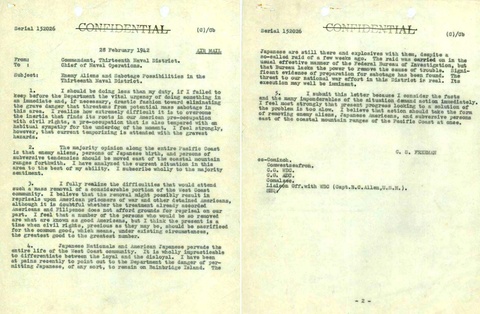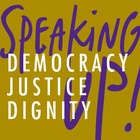Read Part 2 >>
Records of the Selective Service System, Record Group 147
Until recently Selective Service draft registration records from World War I and II were stored at field offices of the National Archives. The draft records have been moved to a single, central location at the National Archives at St. Louis and can be accessed there. Draft registration cards typically include address, date and place of birth, employment, citizenship, date of registration, and descriptive information. Using Gordon Hirabayashi again as an example, his draft card indicates that he registered on October 16, 1940, and noted that “I am a conscientious objector.”1

Click to enlarge. Page four of the “Statement of United States Citizen of Japanese Ancestry” completed by James Yosh Tamura on January 6, 1945, while at the Minidoka Relocation Center. This is the revised version of the form introduced on November 16, 1944. Alien and Japanese American Registration Forms, Idaho State Headquarters, Boise, Box 2, Records of the Selective Service System, Record Group 147, National Archives at Seattle.
Selective Service System records remaining in Seattle include 370 “Statement of United States Citizen of Japanese Ancestry” forms. Officially identified as “Form DSS 304A” these forms are also known as the “Loyalty Questionnaire.” The forms held in Seattle were completed in 1943 and 1944 at locations around the country, including some from the Minidoka Relocation Center.
The completed forms were returned to local Selective Service boards in Idaho, Oregon, and Washington and transferred to the National Archives from there. A list of the names of individuals who completed the forms is available. It is unknown why this specific set of forms, rather than others, was kept and reached Seattle.
The forms include information about the person’s address, date and place of birth, marital status, parents’ address, names of relatives in military service and in Japan, education, foreign travel, employment, membership in organizations, knowledge of foreign languages, sports and hobbies, personal references, foreign investments, contributions, magazines and newspapers read and, most significantly, questions 27 & 28,
27. Are you willing to serve in the armed forces of the United States of America on combat duty, wherever ordered?
28. Will you swear unqualified allegiance to the United States of America and faithfully defend the United States from any or all attack by foreign or domestic forces, and forswear any form of allegiance or obedience to the Japanese emperor, or any other foreign government, power or organization?
Individuals answering “no” to both came to be called “no–no boys.” The text of questions was changed in a November, 1944, revision of the form.
Most, but not all, respondents indicated “yes” to both questions. A few, who answered “no,” added comments. Comments on question 27 include, “Yes, provided I can get into any branch of the armed forces on the same basis as any other American,” “Yes, if inducted as an American, not in Japanese battalion or division (no discrimination),” “No, because I have already applied for my papers for renunciation of American citizenship,” and by a man born in Portland, “No, because I intend to go to Japan to live as soon as it is possible.” The same individual replied to question 28, “No, because I consider myself a Japanese subject.”
Other answers to question 28 include, “No, because I don’t know what I’m fighting for” and “No, because I believe my future lies in Japan as her citizen.”2
The National Archives at Riverside has nearly two hundred “Statements of United States Citizens of Japanese Ancestry” from draft age men living in Arizona.
Records of the War Assets Administration, Record Group 270
The War Assets Administration was responsible for the orderly disposal of surplus federal property following the end of World War II. At the National Archives at Seattle there is a partial box of files related to disposal of the Minidoka Relocation Center. The facility was declared surplus in December 1945. The files contain administrative and public correspondence, an inventory of the camp facilities, site plans, and forms. Some of the correspondence reflects controversies and confusion about the disposal process.3
The National Archives at Riverside holds records related to the disposal of the Colorado River and Gila River Relocation Centers. The National Archives at Denver has similar records for the Heart Mountain, Amache, and Topaz Relocation Centers.
Records of the Immigration and Naturalization Service, Record Group 85
Unfortunately the National Archives at Seattle does not have Immigration and Naturalization records related to involuntary mass removal and incarceration of Japanese Americans. However, the National Archives at Riverside has records related to the individuals living in Southern California. Included are records of administrative files from the Los Angeles District Office relating to Enemy Aliens. These include lists of individuals transferred between detention and “relocation centers,” alien enemy parole reports, arrests made in December, 1941, and lists of Japanese detained. There are also 73 linear feet of Enemy Alien Case Files from 1941-1948 pertaining to those of German, Italian, and Japanese decent.
Records of Naval Districts and Shore Establishments, Record Group 181
The vast majority of military records from this era are held at the National Archives at College Park. In Seattle there are some records from the 13th Naval District. They include about a box of mimeographed summaries of intelligence reports compiled by the District in 1942. The reports are included with other documents and subject files from the Commandant’s Office in the box.
Each report covers a two-week period and routinely includes a section titled “Japanese Activities” as well as reports of activities of Germans, Italians, and Communists. The reports show that the Navy was very carefully monitoring the “internment” process, court trials, activities in “assembly centers” and “relocation centers,” and any activities they conceived to be anti-American.
For example, one report states, “From the Eleventh Naval District information has been received that the Western Bodhi Society, proceeding under the guise of the Buddhist religion, has as its real purpose the defeat of America in any war with Japan.”
Another report noted, “Mary Farquharson, ex-Washington State Senator and Communist ‘fellow traveler’ accepted an invitation tended by Rev. Daisuke Kitagawa to speak at Tule Lake.” Directly related to the National Archives building site in Seattle, one report noted that in June 1942 a nearby field of turnips on a now abandoned Japanese immigrant farm had blossomed. The field, adjacent to the Naval Air Station, was immediately mowed out of concern it might somehow direct enemy pilots to the military base. Another file contains Western Defense Command and Fourth Army Public Proclamations No. 1 to 5.4
The National Archives at Riverside has similar records focused on southern California, generally, and Terminal Island, in particular, including orders to remove Japanese Americans from their homes on the island and Naval Intelligence reports.

Click to enlarge. Letter from the Commandant of the Thirteenth Naval District to the Chief of Naval Operations dated February 28,1942 advocating the mass removal Japanese Americans from the West Coast. File A8-5, Box 7, Central Subject Files (Entry 13ND-3), 1942-1943, Commandant's Office, 13th Naval District, Records of Naval Districts and Shore Establishments, Record Group 181, National Archives at Seattle.
Records of the War Relocation Authority, Record Group 210
The National Archives at Seattle does not have records created by the War Relocation Authority, but there are some at the National Archives at San Francisco, including records of regional and field assistant directors’ offices containing general subject files, outgoing correspondence of the regional office, general subject files of the field assistant director, and press digests. They also hold records of the Evacuee Property Division, including general subject files, evacuee real property inventory cards, and contraband property inventories.
The National Archives at College Park and at Washington DC
The vast majority of records at NARA related to the removal and incarceration of Japanese Americans are stored in the Washington DC area at the National Archives at College Park (commonly called Archives II) and the National Archives at Washington DC (commonly called Archives I). The College Park facility holds two board categories of records—non-textual, meaning photographs, maps, charts, motion picture film, electronic and sound records, and textual, referring to paper document. An example of non-textual records is the photographs of Dorothea Lange.
The largest collection of records in NARA’s custody relating to the Japanese American exclusion and detention years were created by the War Relocation Authority, Record Group 210. They include almost 17,000 photographs, computer punch cards, a handful of sound records and motion picture films, as well as plans, correspondence, and subject files. These records may be subject to privacy restrictions under the Freedom of Information Act and require screening before they can be released to researchers. Some have been microfilmed, including publications, C53, Field Basic Documentation of the War Relocation Authority, 1942-1946, and M1865 Final Accountability Rosters of Evacuees at Relocation Centers, 1944-1946. A related microfilm publication is M1342, Community Analysis Reports and Community Analysis Trend reports of the War Relocation Authority. There is a general description of the records at www.archives.gov/research/guide-fed-records/groups/210.html
Other records include alien detention files and redress files from the Department of Justice, Record Group 60 (see www.archives.gov/research/japanese-americans/internment-files.html), records of the Office of Provost Marshal, Record Group 389, Western Defense Command, Record Group 499, and the Commission on Wartime Relocation and Interment of Citizens, Record Group 220. There is information about military records here: www.archives.gov/research/japanese-americans/military.html
A good place to start a search of these records is www.archives.gov/research/japanese-americans or doing a name search here aad.archives.gov/aad in the section titled “Records about Japanese Americans Relocated during World War II” within the “World War II” section. Other NARA websites include www.archives.gov/publications/prologue/2009/winter/wra.html and www.archives.gov/research/japanese-americans/order.html. Two non-NARA sites include www.youtube.com/watch?v=YuvequgOV7w and an article by Pamela Loos-Noji kinworkconnections.com/Kinwork_Connections/Specialties_files/artjp%20ngs%20mybit.pdf
How to Contact the National Archives at Seattle
Please contact an archivist at NARA if you would like to review any of these records. The National Archives at Seattle is located at 6125 Sand Point Way NE, Seattle. The research room is open from 7:45 AM until 4:15 PM, Monday through Friday, from 9:00 AM until 4:00 PM on the second Saturday of each month, and closed on federal holidays. Telephone inquiries can be directed to (206) 336-5115. While you are welcome to drop in, you will make the best use of your time if you e-mail or call a few days in advance of your visit and contact an archivist. Records can be pulled and held for your arrival. Photograph identification and registration as a researcher is required to work with original records. Talk with an archivist about any questions you have.
Notes:
1. World War II draft registration card, Records of the Selective Service System, Record Group 147, National Archives at St. Louis.
2. Alien and Japanese American Registration Forms, Records of the Selective Service System, Record Group 147, National Archives at Seattle.
3. Real Property Case Files, Idaho Facilities, Box 30, Regional Office, Seattle, Records of the War Assets Administration, Record Group 270, National Archives at Seattle.
4. Subject Files (Entry 13ND-3), 1942-1943, Boxes 5-6 & Regular Navy Files, 1942-1943, Box 118, Records of Naval Districts and Shore Establishments, Record Group 118, National Archives at Seattle.
* * *
* Ken House will be leading “Workshop and Research Opportunities in the National Archives Relating to the Japanese American Experience” a special off-site workshop that will be part of JANM’s National Conference, Speaking Up! Democracy, Justice, Dignity on July 4-7, 2013 in Seattle, Washington. For more information about the conference, including how to register, visit janm.org/conference2013.
© 2013 Ken House






